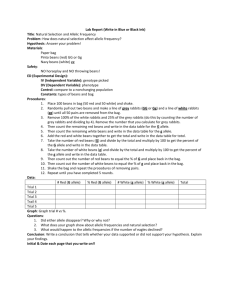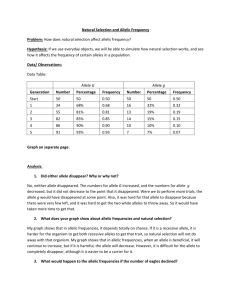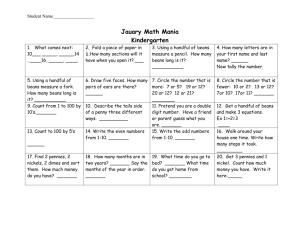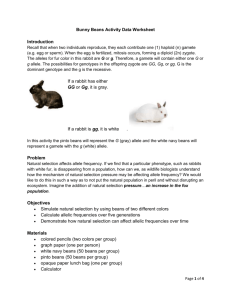D-2 Naked Bunny Lab
advertisement
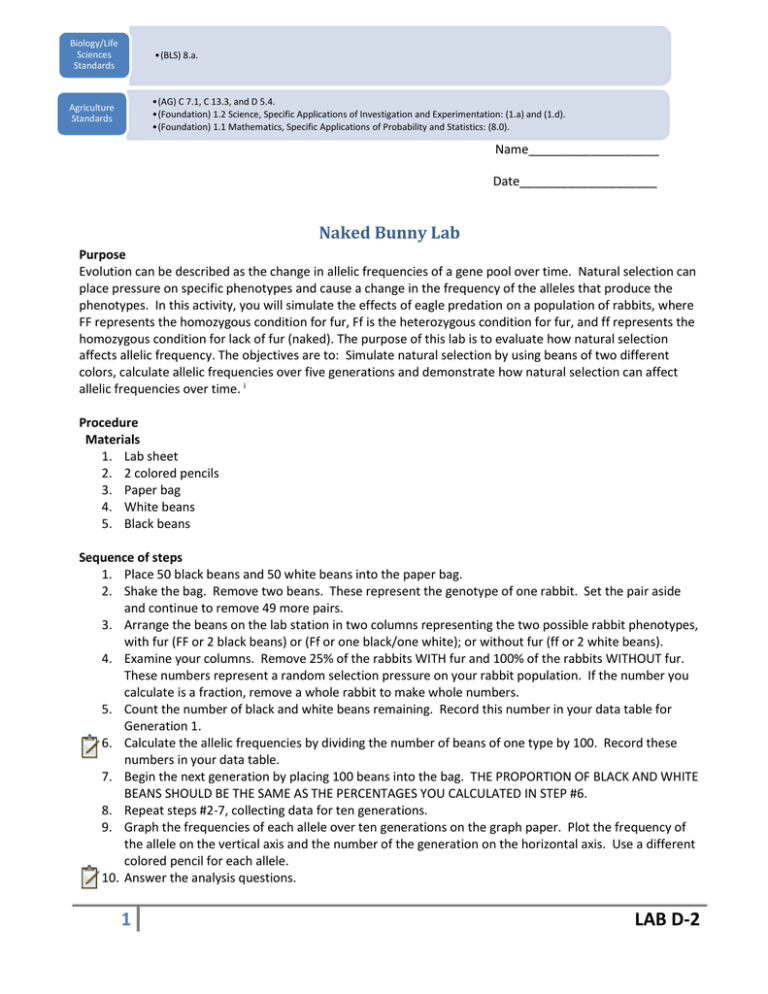
Biology/Life Sciences Standards •(BLS) 8.a. Agriculture Standards •(AG) C 7.1, C 13.3, and D 5.4. •(Foundation) 1.2 Science, Specific Applications of Investigation and Experimentation: (1.a) and (1.d). •(Foundation) 1.1 Mathematics, Specific Applications of Probability and Statistics: (8.0). Name___________________ Date____________________ Naked Bunny Lab Purpose Evolution can be described as the change in allelic frequencies of a gene pool over time. Natural selection can place pressure on specific phenotypes and cause a change in the frequency of the alleles that produce the phenotypes. In this activity, you will simulate the effects of eagle predation on a population of rabbits, where FF represents the homozygous condition for fur, Ff is the heterozygous condition for fur, and ff represents the homozygous condition for lack of fur (naked). The purpose of this lab is to evaluate how natural selection affects allelic frequency. The objectives are to: Simulate natural selection by using beans of two different colors, calculate allelic frequencies over five generations and demonstrate how natural selection can affect allelic frequencies over time. i Procedure Materials 1. Lab sheet 2. 2 colored pencils 3. Paper bag 4. White beans 5. Black beans Sequence of steps 1. Place 50 black beans and 50 white beans into the paper bag. 2. Shake the bag. Remove two beans. These represent the genotype of one rabbit. Set the pair aside and continue to remove 49 more pairs. 3. Arrange the beans on the lab station in two columns representing the two possible rabbit phenotypes, with fur (FF or 2 black beans) or (Ff or one black/one white); or without fur (ff or 2 white beans). 4. Examine your columns. Remove 25% of the rabbits WITH fur and 100% of the rabbits WITHOUT fur. These numbers represent a random selection pressure on your rabbit population. If the number you calculate is a fraction, remove a whole rabbit to make whole numbers. 5. Count the number of black and white beans remaining. Record this number in your data table for Generation 1. 6. Calculate the allelic frequencies by dividing the number of beans of one type by 100. Record these numbers in your data table. 7. Begin the next generation by placing 100 beans into the bag. THE PROPORTION OF BLACK AND WHITE BEANS SHOULD BE THE SAME AS THE PERCENTAGES YOU CALCULATED IN STEP #6. 8. Repeat steps #2-7, collecting data for ten generations. 9. Graph the frequencies of each allele over ten generations on the graph paper. Plot the frequency of the allele on the vertical axis and the number of the generation on the horizontal axis. Use a different colored pencil for each allele. 10. Answer the analysis questions. 1 LAB D-2 Data Table: Generation Start 1 2 3 4 5 6 7 8 9 10 Number 50 Allele F Percentage 50 Frequency 0.50 Number 50 Allele f Percentage 50 Frequency 0.50 Graph your data collected above. Be sure to label the axes according to the directions (step #9) and give your graph an appropriate title. 2 LAB D-2 Analysis Questions: 1. Did either allele disappear? Why or why not? 2. What does your graph show about allelic frequencies and natural selection? 3. What would happen to the allelic frequencies if the number of eagles declined? i Zallo, Izaskun (2008). Naked Bunny Lab. Pleasant Grove High School Agriculture Department 3 LAB D-2

